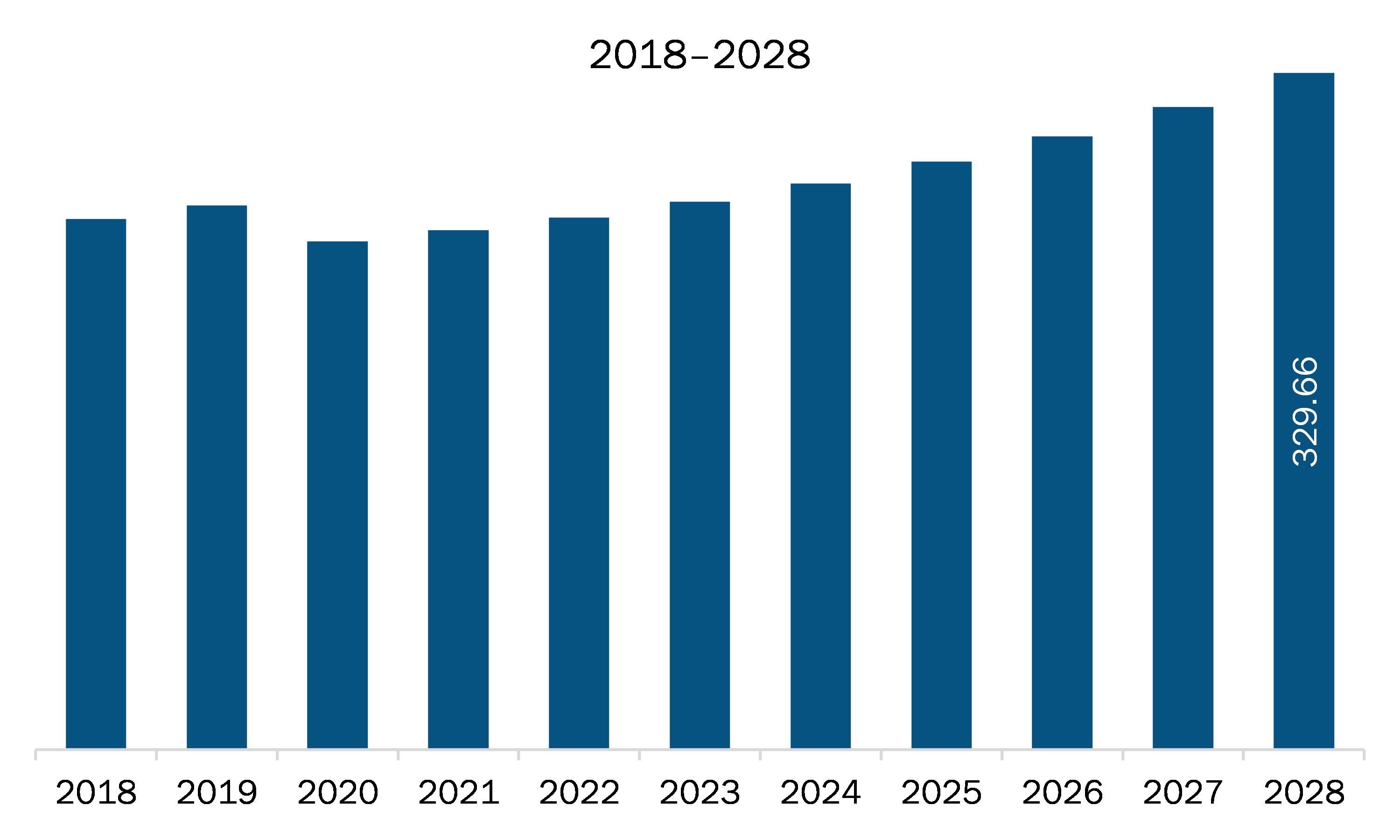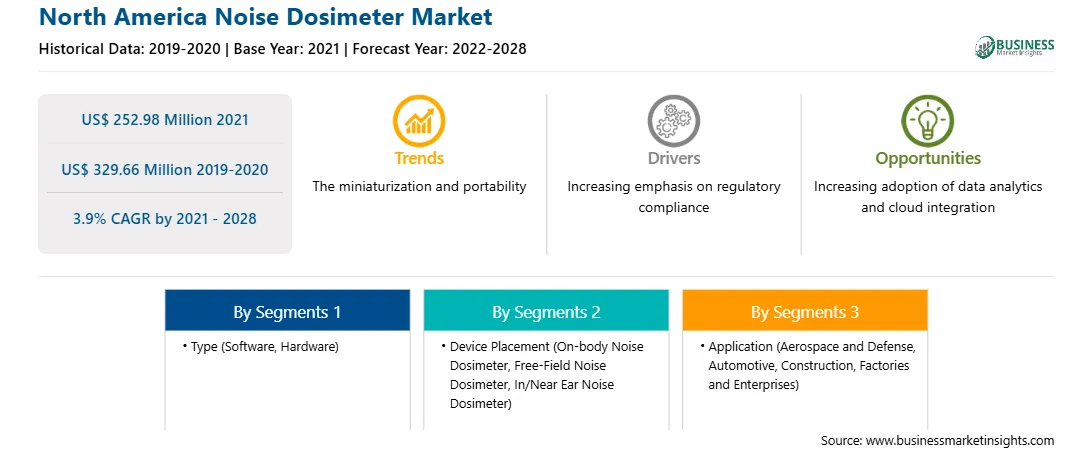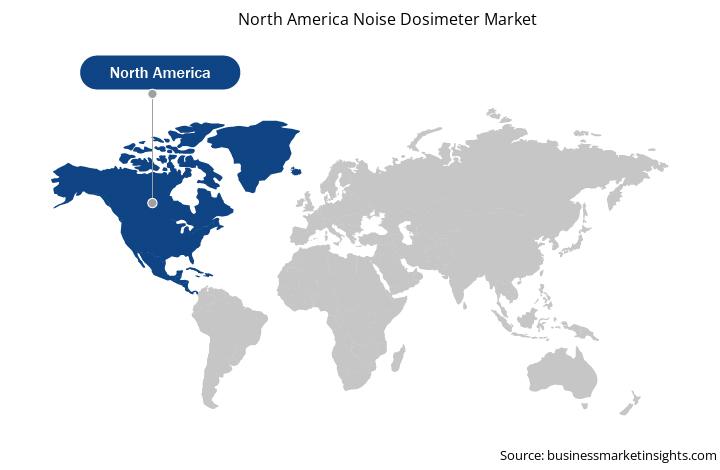The US, Canada, and Mexico are the key contributors to the North America noise dosimeter market. The US and Canada are developed countries in terms of modern technologies, standard of living, and infrastructure. North America is one of the frontrunners in terms of developing and accepting new, advanced technologies. The significant adoption of technologies in the last five years has fueled the adoption of various technologies across industries such as aerospace & defense and construction.
Noise exposure and the resulting hearing loss are well-known in military service. Numerous studies have found that active-duty servicemen and women suffer from high rates of noise-induced hearing injury (NIHI), and new figures from the US Department of Veterans Affairs show that the number of veterans with hearing loss is expanding at an alarming rate. The US Department of Defense (DoD) updated its Hearing Conservation Program in 2010 and in 2017 has revised the DoD Design Criteria Standard Noise Limits (MIL-STD-1474E), which defines allowable noise levels in the design of all military acquisitions, including weapons and vehicles, to reduce hearing loss. This has resulted in the high adoption of noise dosimeter across the US DoD, thereby contributing to the growth of the market across the region.
North America has the presence of technologically advanced infrastructures and industrial sectors to fuel the innovation. North America leads the global dosimeter industry. The US, which is the largest market across the globe, is witnessing marginally higher growth than the global market average. According to a 2021 report by the World Trade Organization (WTO), demand for traded goods will be driven by North America (11.4%) due to large fiscal injections in the US, which would stimulate other economies through the trade channel. This has led to a stagnant demand for the noise dosimeter in the region as there are several restraining factors. The market players in North America are also open to the critical supply and supply chain. In addition, as per the Bureau of Labor Statistics, automakers and their suppliers employ ~1 million people in the US. These employees’ welfare is the top concern for corporate leaders that leads to the increasing usage of noise dosimeter in the region. However, the imposition of lockdown strategy adopted by respective governments due to COVID-19 has resulted in slower production of noise dosimeters. Thus, scarcity of workforce coupled with halt has resulted in a substantial loss in the North America noise dosimeter market.

Strategic insights for the North America Noise Dosimeter provides data-driven analysis of the industry landscape, including current trends, key players, and regional nuances. These insights offer actionable recommendations, enabling readers to differentiate themselves from competitors by identifying untapped segments or developing unique value propositions. Leveraging data analytics, these insights help industry players anticipate the market shifts, whether investors, manufacturers, or other stakeholders. A future-oriented perspective is essential, helping stakeholders anticipate market shifts and position themselves for long-term success in this dynamic region. Ultimately, effective strategic insights empower readers to make informed decisions that drive profitability and achieve their business objectives within the market.

| Report Attribute | Details |
|---|---|
| Market size in 2021 | US$ 252.98 Million |
| Market Size by 2028 | US$ 329.66 Million |
| Global CAGR (2021 - 2028) | 3.9% |
| Historical Data | 2019-2020 |
| Forecast period | 2022-2028 |
| Segments Covered |
By Type
|
| Regions and Countries Covered | North America
|
| Market leaders and key company profiles |
The geographic scope of the North America Noise Dosimeter refers to the specific areas in which a business operates and competes. Understanding local distinctions, such as diverse consumer preferences (e.g., demand for specific plug types or battery backup durations), varying economic conditions, and regulatory environments, is crucial for tailoring strategies to specific markets. Businesses can expand their reach by identifying underserved areas or adapting their offerings to meet local demands. A clear market focus allows for more effective resource allocation, targeted marketing campaigns, and better positioning against local competitors, ultimately driving growth in those targeted areas.

The noise dosimeter market in North America is expected to grow from US$ 252.98 million in 2021 to US$ 329.66 million by 2028; it is estimated to grow at a CAGR of 3.9% from 2021 to 2028. The microphone could be knocked during the measurements, resulting in inaccurate data for the genuine peak level and maybe over-estimating the time average result. When the dosimeter is knocked or bumped accidently (or purposely), certain current dosimeters have a self-monitoring vibration sensor that identifies samples throughout the run, and these findings can be identified in the software and erased after downloading. The dosimeter's vibration sensor is also useful for monitoring while the instrument is not being worn. This serves as a warning when the operator has taken it off and placed it down. Even if the operator is just sitting at a bench working regularly, the dosimeters may identify when the device is being worn. The available equipment in the early days of personal noise dosimetry measurement merely produced an overall noise dosage percentage result based on one of the procedures set by regulatory organizations across the world. Greater data, such as peak levels, maximum levels, time average levels, and normalized, time-weighted average levels, were gradually included to better depict the measurement and provide more insight into what had transpired. Thus, the constant integration of advanced technologies and sensors are expected to influence the efficiency of noise dosimeters, thereby creating growth opportunities for the market.
The North America noise dosimeter market is segmented on the bases of type, device placement, and application. Based on type, the market is segmented hardware and software. Hardware segment held the largest market share in 2020. Based on device placement, the North America noise dosimeter market is segmented into on-body noise dosimeter, free-field noise dosimeter, and in/near-ear noise dosimeter. On-body segment dominated the market in 2020. In terms of application, the market is segmented into aerospace and defense, automotive, construction, and factories and enterprises. Factories and enterprises segment held the largest market share in 2020.
A few major primary and secondary sources referred to for preparing this report on the noise dosimeter market in North America are company websites, annual reports, financial reports, national government documents, and statistical database, among others. Major companies listed in the report are 3M; Brüel AND Kjær; Casella (IDEAL INDUSTRIES, INC.); CESVA INSTRUMENTS SLU; Extech Instruments (FLIR Systems); LARSON DAVICS INC (MTS Systems Corporation); Norsonic AS; Svantek; and TSI.
The North America Noise Dosimeter Market is valued at US$ 252.98 Million in 2021, it is projected to reach US$ 329.66 Million by 2028.
As per our report North America Noise Dosimeter Market, the market size is valued at US$ 252.98 Million in 2021, projecting it to reach US$ 329.66 Million by 2028. This translates to a CAGR of approximately 3.9% during the forecast period.
The North America Noise Dosimeter Market report typically cover these key segments-
The historic period, base year, and forecast period can vary slightly depending on the specific market research report. However, for the North America Noise Dosimeter Market report:
The North America Noise Dosimeter Market is populated by several key players, each contributing to its growth and innovation. Some of the major players include:
The North America Noise Dosimeter Market report is valuable for diverse stakeholders, including:
Essentially, anyone involved in or considering involvement in the North America Noise Dosimeter Market value chain can benefit from the information contained in a comprehensive market report.